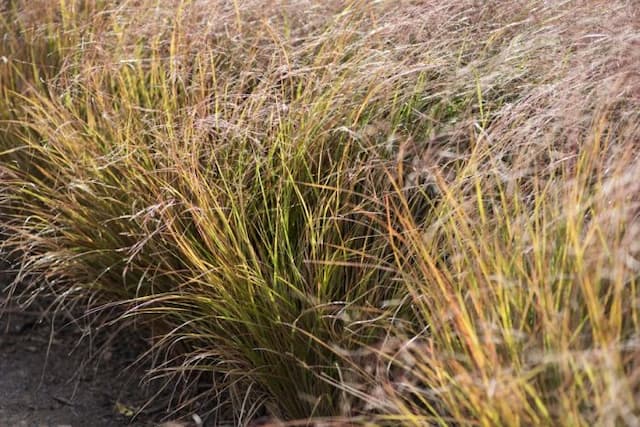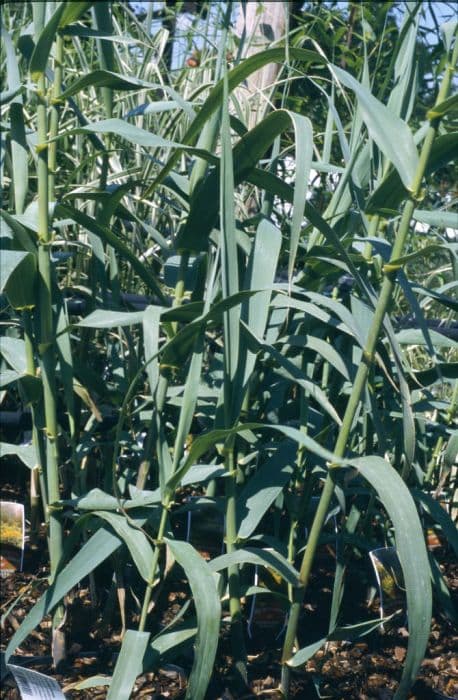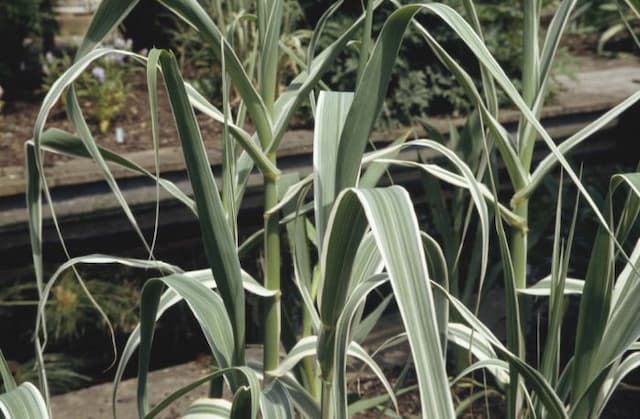Oriental fountain grass 'Shogun' Pennisetum orientale 'Shogun'

ABOUT
'Shogun' is a deciduous, perennial grass, to 1.2m tall, producing a relatively-upright clump of bluish-green leaves, topped with silvery-pink flowers from midsummer to the first frosts
About this plant
 Names
NamesFamily
Poaceae
Synonyms
Oriental Fountain Grass, Shogun Fountain Grass
Common names
Pennisetum orientale 'Shogun'.
 Characteristics
CharacteristicsLife cycle
Perennials
Foliage type
Deciduous
Color of leaves
Green
Flower color
Pink
Height
2-3 feet (0.6-0.9 meters)
Spread
1-2 feet (0.3-0.6 meters)
Plant type
Grass
Hardiness zones
5
Native area
Eastern Asia
Benefits
 General Benefits
General Benefits- Ornamental appeal - The feathery, bottlebrush flowers and graceful foliage of Pennisetum orientale 'Shogun' add aesthetic value to gardens.
- Drought tolerance - Once established, it is highly tolerant of dry conditions, reducing the need for frequent watering.
- Low maintenance - Requires minimal care beyond the occasional trimming to keep it looking tidy.
- Fast growth - It grows quickly, providing a rapid effect in landscaping projects.
- Wildlife attraction - Its flowers attract pollinators such as bees and can be a food source for birds.
- Season-long interest - Offers visual interest from midsummer until frost with its persistent flowers.
- Erosion control - The robust root system can help to stabilize soil and prevent erosion.
- Versatility - Suitable for a variety of landscape uses including borders, mass plantings, and as an accent plant.
 Medical Properties
Medical PropertiesThis plant is not used for medical purposes.
 Air-purifying Qualities
Air-purifying QualitiesThis plant is not specifically known for air purifying qualities.
 Other Uses
Other Uses- Oriental fountain grass can be used in floral arrangements, either fresh or dried, to add texture and movement to bouquets and displays.
- This plant is often included in wildlife gardens to attract birds that feed on the seeds, providing an ecological benefit and supporting local biodiversity.
- Oriental fountain grass can serve as a cover for ground-nesting insects, thus playing a role in maintaining insect populations, which are crucial for pollination in gardens.
- It can be employed as a living mulch in garden beds, where it suppresses weeds with its dense foliage, reducing the need for chemical herbicides.
- This ornamental grass can be used in erosion control on slopes and banks, as its root system helps to stabilize the soil and prevent runoff during heavy rains.
- The grass can be part of a sensory garden, as its soft texture and the rustling sound of its leaves when the wind blows provide tactile and auditory stimuli.
- Oriental fountain grass can be used in xeriscaping, a landscaping method that reduces or eliminates the need for irrigation, thanks to its drought tolerance.
- Photographers may use oriental fountain grass as a backdrop or accent in outdoor portrait photography due to its aesthetic appeal and height variation.
- Environmental artists may incorporate this plant into installations or land art pieces for its sculptural qualities and seasonal color changes.
- It can be used as a natural dye source, where parts of the plant, particularly the seed heads, can provide color for fabrics and textiles.
Interesting Facts
 Feng Shui
Feng ShuiThe Oriental Fountain Grass is not used in Feng Shui practice.
 Zodiac Sign Compitability
Zodiac Sign CompitabilityThe Oriental Fountain Grass is not used in astrology practice.
 Plant Symbolism
Plant Symbolism- Beauty: Oriental Pennisetum is admired for its graceful flower plumes and arching foliage, symbolizing natural beauty and elegance.
- Resilience: This hardy plant thrives in a variety of conditions, representing the ability to endure and adapt to life's challenges.
- Ease: The carefree growth habit of the Oriental Pennisetum signifies an easygoing approach to life and the importance of going with the flow.
- Harmony: With its flowing form that sways gently in the wind, it embodies balance and harmony with nature.
 Water
WaterOriental fountain grass should be watered deeply once a week, providing about 1 to 1.5 inches of water each time to soak the soil thoroughly. During hot or dry spells, you might need to water more frequently to maintain consistent soil moisture. It’s important not to overwater, as this can lead to root rot. The best method is to use a garden hose or drip system to deliver water directly to the base of the plant, avoiding wetting the foliage. Adjust the amount of water according to the season, with less frequent watering needed in the cool months.
 Light
LightOriental fountain grass thrives in full sunlight but can also tolerate partial shade. The ideal spot for this grass is a location where it receives at least 6 hours of direct sunlight daily for optimum growth and flowering. Avoid deep shade areas as this can lead to poor growth and sparse flowering.
 Temperature
TemperatureOriental fountain grass prefers temperatures between 60 and 80 degrees Fahrenheit for optimal growth. It can survive minimum temperatures down to 20 degrees Fahrenheit, but it may not withstand prolonged frost. The plant is heat tolerant and can endure temperatures up to 90 degrees Fahrenheit, but during extremely high temperatures, adequate watering is essential to prevent stress.
 Pruning
PruningPruning oriental fountain grass helps to maintain its shape and encourage new growth. Cut back the foliage to about 4 to 6 inches above the ground in late winter or early spring before new growth begins. This grass should be pruned annually to remove old growth and make way for fresh, vibrant blades and seed heads.
 Cleaning
CleaningAs needed
 Soil
SoilOriental Fountain Grass prefers well-draining soil enriched with compost, with a pH range of 5.8 to 6.8. A mix of garden soil, peat, and sand is ideal to ensure proper drainage and fertility.
 Repotting
RepottingOriental Fountain Grass, being a perennial, does not require frequent repotting. If grown in containers, repot every 2-3 years to refresh the soil and manage root growth.
 Humidity & Misting
Humidity & MistingOriental Fountain Grass thrives in average humidity conditions typical of outdoor environments and does not require specific humidity adjustments when grown outdoors.
 Suitable locations
Suitable locationsIndoor
Ensure bright light and good airflow for indoor Oriental Fountain Grass.
Outdoor
Plant in full sun, well-draining soil; water regularly until established.
Hardiness zone
Oriental Fountain Grass is suitable for USDA zones 6-9.
 Life cycle
Life cyclePennisetum orientale 'Shogun', commonly known as Oriental Fountain Grass, begins its life cycle when a seed germinates in the soil, typically in spring when the soil has warmed sufficiently. The seedling emerges, developing a primary root system and grass-like foliage as it enters the vegetative stage, where it focuses on growth and establishment. During the growing season, with adequate water and sunlight, 'Shogun' rapidly forms a clump of arching foliage and begins to produce characteristic feathery flower plumes by late summer or early fall. After flowering, the plant enters a period of senescence where the seeds mature and are dispersed naturally or through human intervention, completing the reproductive stage. Oriental Fountain Grass is a perennial plant and will undergo a period of dormancy in winter, with foliage often dying back depending on the climate. In the subsequent spring, the plant will break dormancy, resuming growth from the root system to begin the cycle anew.
 Propogation
PropogationPropogation time
Late spring-Early summer
Pennisetum orientale 'Shogun', more commonly known as Oriental Fountain Grass, is typically propagated through the division of clumps. The best time for this process is during the spring, as the grass comes out of dormancy and begins active growth. To propagate, one should carefully dig up an established clump of grass and gently separate it into smaller sections, ensuring that each new division has a good amount of roots and several shoots. These divisions can then be replanted into well-draining soil while maintaining the same depth they were originally growing. Keeping the newly planted divisions moist until they are established is crucial, and this method often results in a high success rate of creating new, healthy grass clumps that will grow and mature in the upcoming seasons.









